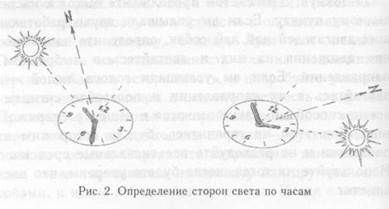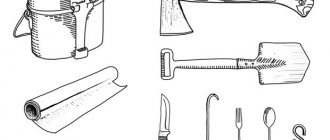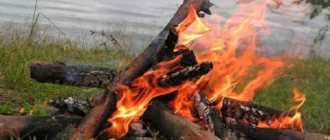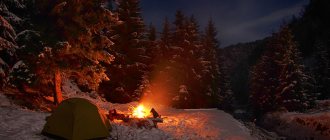A modern person, lost in the forest with a mobile phone at hand, immediately starts searching for what to do. And he may find some good advice, the first of which will be: don’t panic.
The work of rescue services is organized in such a way that you can call “112” without using a SIM card, if this is not the territory of your telecom operator. The main thing is that the lost person can explain where he is.
And to do this, you need to be attentive in the forest, be able to notice such signs as the quarter post (and there are special marks on it), remember which highway you went to the forest from, what rivers, lakes, and settlements are nearby. But let's look in order at which actions are best to take and which ones should not be done!
What to do if you get lost in the forest?
Action Reminder
- If you realize that you are lost, stop and calmly examine everything you see around you. Listen to the sounds of the forest. The barking of dogs coming from a distance (heard at a distance of 2-3 km), the voices of people, the sounds of operating equipment, the railway (a running train can be heard at a distance of up to 10 km) can suggest the direction of movement.
- A tall tree can help, so you can climb it and look around the surroundings from above.
- If you have reached rescuers and are sure that they are looking for you, it is better to stay in one place and light a fire. The smoke will reveal your location.
- You can knock on wood with a stick from time to time; these sounds can be heard over long distances.
- If your cell phone is dead and you have to find your way on your own, try to navigate by the sun: to do this, you need to remember in which direction the nearest settlement is or where you came from. In the early morning the sun is in the east, moves to the south closer to noon, and drops to the west by 19 o'clock. If the night sky is cloudless, you can find the North Star, which will show the direction to the north. The polar star is not the brightest in the entire sky, but the most noticeable in the constellation Ursa Minor, which is shaped like a ladle. The North Star is located at the end of the handle of this bucket. At night, at the risk of getting injured in the dark, you should not move; you can only determine and remember the direction.
- A reminder if you get lost in the forest suggests that you need to leave evidence of your stay in a particular place: a handkerchief tied to a tree, chocolate packaging, notches in trees, an arrow made of stones, etc.
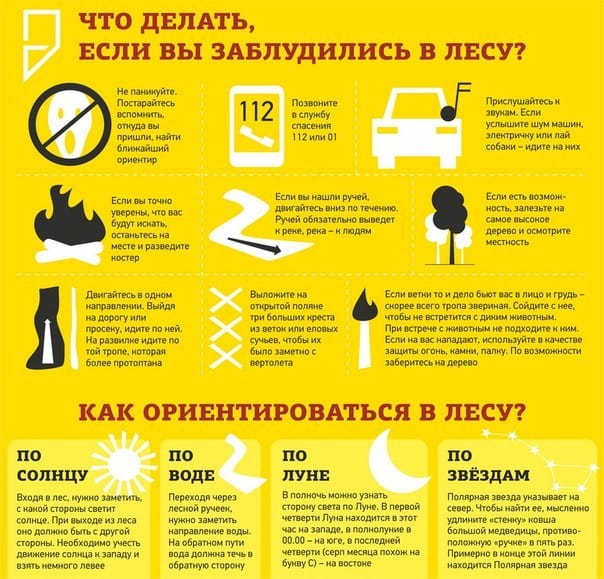
Reminder for those who are lost in the forest
- If during inspection you find a trail, determine whether it is an animal trail. The animal trail, of course, will lead you to a watering hole, and from it you can find a stream or river, following the flow of which sooner or later you will reach a populated area. But it’s not worth meeting wild animals again. If the branches of the bushes close in the area of your chest, then the path is an animal one. Be careful!
- If there is no daylight, you should not move further. Organize your overnight stay: before dark, gather enough fuel to last until the morning, and materials to make a fire. Dig up (or clear) the area of the fire (there should be no flammable materials around the fire for 1-1.5 meters), stock up on water for boiling and drinking and for fire prevention in dry weather.
On this topic ▼
Orienteering rules: how not to get lost in the forest
- Go to sleep not with your feet or head towards the fire, but with your side, parallel. Each tourist prepares matches in advance to eliminate the risk of getting wet: he covers the top part of each match with wax, stores them in a hermetically sealed tin case, and stores separately the part of the box suitable for igniting the match head.
- If your food supplies are running low, you can look for nuts, mushrooms, and catch fish if you have gear and bait. But you should remember that mushrooms are cooked by draining the boiled water twice. And they select those whose names they know for sure as edible.
- If you are sleeping by the fire, you should not be afraid of an attack from animals; they themselves are afraid of people and fire, and will not attack unless provoked on purpose or by accident. Just be careful and calm.
What to do if you are lost in the forest - step-by-step instructions
If suddenly a situation occurs when you cannot find your way home and find your bearings, the main thing is not to fall into despair; there are special instructions that answer the question of what to do if you are lost in the forest.
- Calm down! Panic is the most dangerous enemy; to find a way out you need to stop being afraid and worrying, and start acting.
- Look around the surrounding area, note its features, maybe you will notice a landmark by which you can find a way out, or hear the voices of people, the noise of traffic. If you know how to climb trees, then the time has come to boldly use this skill and look down on everything.
- Dial 112 and describe everything you see so they can find you. If you manage to do this, under no circumstances should you move in any direction, even if it seems to be the right one. This will only complicate your search and get you even deeper lost.
- If you know that they are looking for you in every possible way, help them find you - shout, knock on wood so that the sounds are as loud as possible.
- Stay where you are and wait for rescuers to help you! If you understand that you will have to spend the night in the forest, then information on how to spend the night in the forest will be useful.
What not to do

How not to get lost in the forest
While waiting for rescuers, you should not move around randomly changing directions. It is better to stay in one place or move to where people are if you understand exactly where it is by seeing a power line, gas pipeline and some other precise landmarks.
You should not keep your mobile phone on all the time and explain to relatives who want to talk to you for a long time that the phone may run out of charge before help is on the way and you may actually need the phone.
To the list of what you should not do when lost in the forest, you should add the inadmissibility of drinking unboiled water obtained from natural sources, and immediately eating all the reserves without distributing them into equal parts for at least the next 3-4 days.
When the food runs out, the forest will not let you disappear. In the summer, you can try cooking burdock root, which tastes like potatoes. We have already mentioned mushrooms; you can’t get enough of berries. In winter, tree bark will do as a last resort. Connoisseurs of edible vegetation will definitely look for wild sorrel, orchis, wood sorrel, young shoots of sorrel, etc. in the summer.
You should not build one large fire; it will be more difficult to maintain than several small ones, which are also easier to see from the outside. Even in the rain, you can find dry leaves and branches in the forest if you look under fallen trees. When throwing branches, try not to block the air supply to the initially weakly smoldering flame. When leaving the parking lot, carefully extinguish the fire.
If you see that it is approaching evening and darkness, stop moving and searching, and start arranging your lodgings for the night. The bedding can be made from spruce branches, and from the branches of other trees - a canopy or hut. They will protect from wind and rain.
You shouldn’t fight sleep; the body needs rest in such a situation. If stress keeps you from sleeping, think that morning will come very soon, and help will appear there.
Having set up a parking lot, conduct reconnaissance in different directions, each time indicating with symbols addressed to rescuers in which direction you are going. Try not to deviate from the intended course and leave signs to return to the parking lot before dark. In films and books about lost people, characters “walk in circles” in the forest. This actually happens because the right leg makes movements with a little more force than the left. If you do not select any landmarks, the movement will not occur in a straight line. As a rule, those who stay in one place and do not confuse their own tracks are found faster. Move away from the parking lot to search only if you are firmly confident in your abilities.
It is impossible not to think through the upcoming steps, because this threatens with unpleasant consequences.
Reminder: what to do if you are lost in the forest
- Stay calm and save your strength!
- Call rescuers if there is no network, turn off your phone and save charge in case the network appears.
- Look for a landmark in the form of a railroad, highway, or river.
- Send distress signals.
- Look for ways to feed and sleep in the forest.
- When you move in an unfamiliar place, leave traces of your stay: break branches, make cuts on a tree, tie a scarf, sock, etc., so that when you come across this place you can understand that you are walking in circles. It will also be easier for rescuers to look for you by following the trail you left.
Useful tips
Anyone who prepares for everything in advance will not be afraid if he does get lost in the forest. And it is quite possible to prepare in advance, you just need to follow a few rules:
On this topic ▼
Registration of tourist groups
- inform all relatives and friends about your plans, it’s even better to familiarize them with a map of the intended route and return time, arrange “control calls” with someone;
- recharge your cell phone and top up your balance; in addition to your mobile phone, it’s good to have a mechanical watch with you;
- put a whistle around your neck;
- dress brighter and take the same clothes in reserve;
- all the essentials should be in your backpack: matches in a pencil case + wrapped in plastic, a compass, a supply of food (if canned food is hard, stock up on dried meat and fish, they are easy to buy now), water, a first aid kit, a hatchet, a kettle, insect repellent , dry alcohol tablets for ignition.
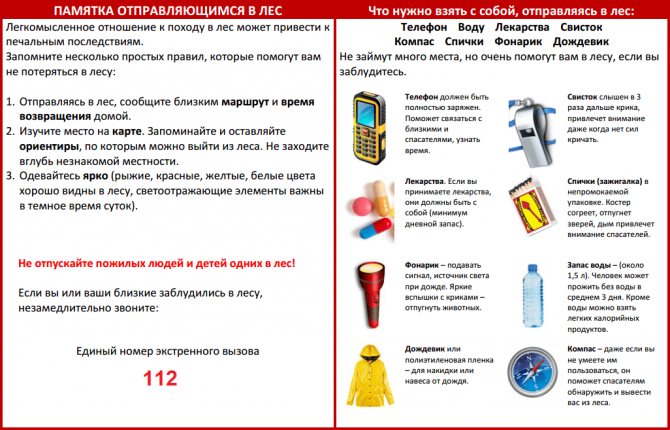
Orientation by the moon
Navigating by the moon is quite difficult, and the accuracy is not very high. But sometimes this is the most affordable way. The moon is often visible even through dense cloud cover when the stars are not visible.
The moon goes through a series of phases of solar illumination:
- New Moon – The Moon is virtually invisible.
- First quarter – the right half of the Moon is illuminated.
- Full moon - the entire disk of the moon is illuminated.
- Last quarter – the left half of the Moon is illuminated (Figure 8).
If the crescent moon conventionally resembles the letter “P” - the Moon is growing (before the full moon, including the first quarter), if the letter “C” is aging (after the full moon, including the last quarter). Growing is more often observed in the evening, aging - in the morning. The full moon is the most favorable time for determining the directions of the horizon.
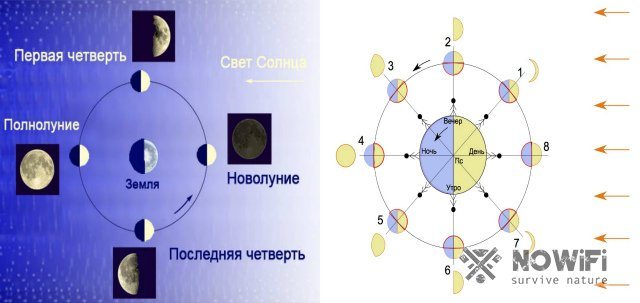
Figure 8. Moon phases
In the first 1/4 the Moon is approximately located:
- 19:00 – south;
- 1:00 – west;
- 7:00 – not visible.
During a full moon, the Moon is approximately located:
- 19:00 – east;
- 1:00 – south;
- 7:00 – west.
In the last 1/4 the Moon is approximately located:
- 19:00 – not visible;
- 1:00 – east;
- 7:00 – south.
You can also navigate with the help of a clock, just like by the daylight, but it is not the time of true noon that is determined (a person orients himself by the Sun), but the moment of the upper culmination. During the full moon, this moment and local midnight coincide, orientation along the full disk of the Moon is carried out similarly to orientation towards the Sun.
The problem is that it is impossible to speculatively determine whether the Moon is in the full moon phase.
For several days before and after the full moon, the appearance of the night star is almost unchanged, and the deviation, which is caused by an incorrect phase, can be very significant; the lunar disk shifts by 12° per day.
In 1/4, the Moon reaches its climax 6 hours before midnight, in the last 1/4 - 6 hours after local midnight. Since the 1/4 moment is visually determined easily, the orientation is performed more accurately.
There is a general rule for orientation with the help of the Moon - you need to speculatively divide the diameter of the night luminary into 12 shares and determine how many parts the unlit part of the Moon occupies - exactly how much will the time of culmination differ from the local midnight. The waxing moon culminates before 00:00, the aging moon - after.
The greatest deviations with this method are possible closer to the new moon and full moon. With some experience, the sides of the horizon can be determined with an error of up to 10-15°.
Determining cardinal directions by the sun
The sun in mid-latitudes is (according to daylight hours) about 7 o'clock in the east, at 13 o'clock (noon) in the south, about 19 o'clock in the west. If you have a clock with hands, you can determine the cardinal directions at any time of the day when the Sun is visible. This is done like this: place the watch on the palm of your hand or on a flat surface and turn the end of the watch clockwise towards the Sun. Then, from the center of the dial, mentally draw a line to number 1 (13 o'clock by maternity time - noon) or to number 12 (12 o'clock - noon by local solar time). Divide the resulting angle between the hour hand directed towards the Sun and the line directed towards the number 1 (or 12) in half. The line dividing the angle in half will point north. The end of the line directed towards the Sun will point south (Fig. 2).
